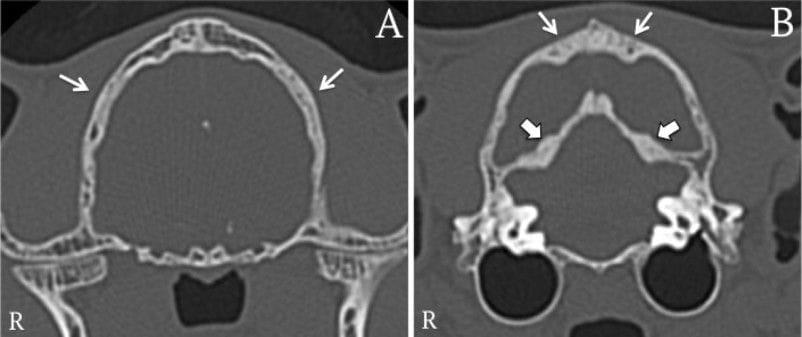- Veterinary View Box
- Posts
- Rare Case: Vitamin A Deficiency Causes Brain Compression in Domestic Cat
Rare Case: Vitamin A Deficiency Causes Brain Compression in Domestic Cat
VRU 2025
Irene Espadas, Emanuele Ricci, Fraser McConnell, Daniel Sanchez-Masian
Background
Vitamin A (retinol) is a vital micronutrient essential for vision, immunity, and neurological health. Felids, unable to convert β-carotene to vitamin A, are particularly susceptible to dietary deficiency. While hypovitaminosis A is well recognized in wild felids, it is rarely reported in domestic cats. Deficiency can result in progressive neurological dysfunction and bony changes in the skull leading to brain compression. This case presents the first comprehensive clinical, imaging, and histopathological description of hypovitaminosis A in a domestic cat.
Methods / Case Description
A seven-year-old, male domestic longhair cat was presented with a five-week history of lethargy, heat-seeking behavior, progressive ataxia, and visual impairment. The cat had been fed exclusively on a home-cooked chicken-based diet for five years. Neurological examination revealed multifocal central nervous system (CNS) deficits, including cerebellovestibular ataxia, tetraparesis, visual impairment, and absent menace response. Diagnostic imaging (MRI and CT) was performed under general anesthesia, followed by biochemical testing and postmortem histopathology.
Results
MRI revealed diffuse thickening and sclerosis of the calvarium, especially the occipital and temporal bones, with compression of the cerebellum and brainstem. The frontal lobes were reduced in size, the tentorium cerebelli was thickened, and mild ventriculomegaly was evident. CT confirmed generalized skull hyperostosis. Plasma retinol was markedly low at 0.1 µmol/L (reference 0.86–2.2 µmol/L), confirming hypovitaminosis A. Postmortem examination revealed diffuse skull hyperostosis causing frontal lobe compression and reduced cerebral volume. Histopathology demonstrated white matter spongiosis, Wallerian degeneration in the corona radiata and optic nerves, and meningeal thickening with mineralization. An incidental finding of systemic mastocytosis involving the spleen and liver was also noted.
Limitations
This report describes a single case, limiting generalizability. The animal was euthanized following anesthetic complications, precluding longitudinal evaluation or response to vitamin A supplementation. While the dietary etiology was presumed, hepatic retinol storage and other metabolic factors were not fully assessed. The incidental systemic mastocytosis may have influenced systemic findings but was not linked causally to hypovitaminosis A.
Conclusions
This case highlights that hypovitaminosis A, though rare, should be considered in domestic cats exhibiting multifocal CNS signs and diffuse skull hyperostosis, particularly when dietary history suggests inadequate vitamin A intake. Early identification and supplementation are crucial, as chronic deficiency can lead to irreversible neurological damage. The study underscores the importance of balanced nutrition in feline diets and demonstrates how MRI and CT can reveal characteristic calvarial and CNS changes associated with retinol deficiency.

A,B) Transverse CT images of the skull in a reconstructionwith a bone algorithm (window level: 450, window width: 4500).There is a generalised increased bone attenuation associated withhyperostosis affecting the temporal and occipital bones (small arrows;images (A) and (B), respectively) and tentorium cerebelli (thick arrowson image (B)).
How did we do? |
Disclaimer: The summary generated in this email was created by an AI large language model. Therefore errors may occur. Reading the article is the best way to understand the scholarly work. The figure presented here remains the property of the publisher or author and subject to the applicable copyright agreement. It is reproduced here as an educational work. If you have any questions or concerns about the work presented here, reply to this email.